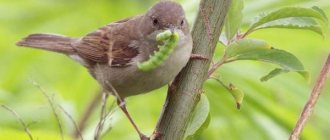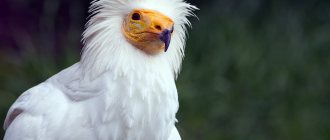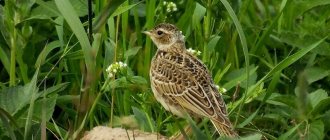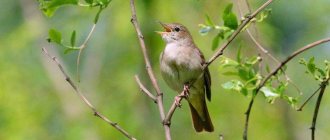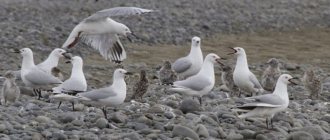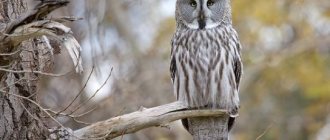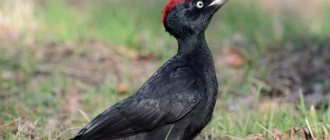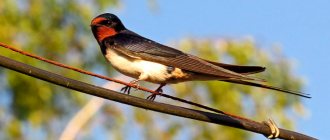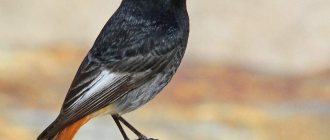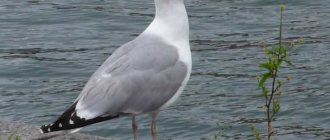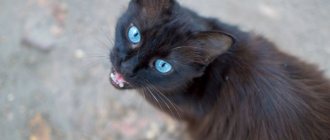- Wild animals
- >>
- Birds
The lyrebird is the national symbol of Australia. It is notable not only for this, but also for its ability to imitate various sounds, both natural and artificial. Male birds are also distinguished by the unusualness and beauty of their huge tail in the shape of a musical instrument - a lyre. Male lyrebirds display their tail so that females will pay attention to them during the mating season.
LIFESTYLE
In summer, lyrebirds live alone, in pairs or in small flocks. In autumn, males occupy nesting areas, the boundaries of which are marked by singing. Having cleared the area of fallen leaves in advance, the male rakes up an earthen mound and begins to perform the courtship dance.
At this time of year, female lyrebirds live in nesting areas that include several male sites. Lyrebirds lead a secretive lifestyle, so people rarely encounter them. During the day, these shy birds hide in the thickets of the tropical jungle. Lyrebirds spend the night in trees.
In Australia, however, there are several places where lyrebirds are so accustomed to the presence of people that they even perform their mating dances in front of them. In case of danger, lyrebirds often flee rather than fly away.
Natural enemies
Some time ago, the lyre bird was endangered, but the measures taken made it possible to preserve this amazing species.
Despite their caution in the wild, lyrebirds are not immune to attacks from felines and foxes.
Humans also pose a threat to this bird, as they are constantly expanding their borders and destroying their natural habitat.
REPRODUCTION
The most amazing phenomenon in the life of a lyrebird is the beautiful mating dances of males. The mating male rakes up an earthen mound up to 15 cm high, climbs onto it, throws his tail spread like a fan forward over his head and sings in a full voice.
The singing of the lyrebird is noted not only for its loudness, but also for its extreme diversity. The mating of males ends when a sufficient number of females ready for mating gather around them. All nesting activities for lyrebirds are carried out exclusively by females.
Lyrebirds build a large bullet-shaped nest from branches, bark, moss, dry leaves and ferns. The nest tray is lined with feathers and thin thread-like roots. The nest is located on the ground, near a tree trunk, on a stump, or less often in the crown of a tree fern. The female lays only one gray egg with dark spots. While the egg is incubating, the female leaves the nest every morning for 3-6 hours and goes to feed. Incubating eggs in lyrebirds is a fairly lengthy process that lasts up to 50 days. The lyrebird chick is born naked and blind. At the age of ten days it is covered with black down. The female feeds the chicks for six to seven weeks.
"A wedding dance
Males are ready to mate at 5 years of age, when their plumage changes and a noticeable, long tail grows. During this period, he develops an area of 700 square meters. meters, clears small branches, builds mounds, 4-8 pieces.
These structures serve as a kind of stage for him to sing and dance with his tail fluffed up. The mating calls begin half an hour before dawn from the top of the tree, and then the performance continues on the prepared hillock.
Thus, the male attracts females, who gather around him in anticipation of mating. During mating, you can hear a wide variety of sounds from the surrounding area, which are woven into the overall song. There is the sound of construction tools and industrial equipment, the growls of predators and the melodies of other birds, the cry of a baby and the melodies of modern performers.
While performing a song, his whole body trembles, his exquisite tail, which covers his back, shakes. A male can simultaneously mate with several females at once, who then rush to build a nesting site on their own.
SINGING
The singing of the lyrebird is unique in its richness of repertoire and ability to reproduce various sounds. The singing, which carries far through the forest, consists of a long and continuous series of melodious sounds, wheezing, groaning and clicking.
A typical lyrebird motif lasts only five to six seconds. More than 80% of the lyrebird's song consists of melodies borrowed from other birds, or imitation of mechanical sounds. The lyrebird can perform excerpts from more than 20 songs in succession from different species of its relatives. Moreover, the bird often imitates not only the singing of birds, but also the sounds caused by the noise of their wings. Lyrebirds have been noted to reproduce sheep bleats, dog barks, car horns, and ax blows.
Funny stories
There are many interesting stories associated with these amazing birds. Here is one of them. Park ranger Dorrito Fenton was fascinated by birdsong and recorded them on film. In 1969, he came across a song that resembled a flute-playing interpretation of melodies known at that time. The worker sent the recording to ornithologists, and they were able to find out that these were indeed melodies performed by a lyrebird.
It turned out that not far from the birds’ habitat there lived a farmer who loved to play the flute. And he had a pet lyrebird who constantly whistled his owner’s favorite songs. Wild birds adopted the style of performance and began to repeat. Thus, in the wild, birds began to have familiar notes in their songs.
The image of a lyrebird is so recognizable that many organizations use it in their logos. Conservatories, national parks.
INTERESTING FACTS, INFORMATION…
- The lyrebird owes its name to the shape of its tail feather, which in a half-opened position resembles a lyre.
- If a male has gathered a large enough “audience” around him during mating, he can sing and dance all day.
- Young lyrebirds adopt a distinctive local “dialect”, learning to sing from adult males.
- Males develop beautiful tail feathers only at the age of 3 to 9 years.
- The first lyrebird tail feathers were collected in Australia in 1797 by a freed prisoner.
- The vocal apparatus of the lyrebird, in contrast to song passerines, which have 7 pairs of muscles of the lower larynx, is formed by three pairs of muscles of the lower larynx and a long narrow sternum; their larynx is more complex, and the vocal muscles are richer than those of other birds. Lyrebirds and bushbirds are classified as semi-songbirds.
Origin of the species and description
Photo: Lyrebird
The lyrebird or lyre bird (Menura) is a bird that belongs to the order Passeriformes, the family Lyrebirds (Menuridae), the genus Menura. Initially, ornithologists argued a lot about the generic affiliation of lyrebirds and wanted to classify them into the order “Culiformes”. There are only two species of these birds, which have lived exclusively on the Australian continent for many millions of years.
Interesting fact: In the so-called "fossil sanctuary" in north-west Queensland, the fossilized remains of a lyrebird, approximately 15 million years old, belonging to the prehistoric species Menura tyawanoides, which dates back to the early Miocene, were found.
The length of male lyrebirds including the tail is no more than 1 meter, with half the length coming from the tail, and their weight is about 1 kg. Females are slightly lighter in weight and slightly shorter in length. The long and unusually shaped tail of these birds is very reminiscent of a lyre (musical instrument), and this feature is characteristic only of males.
Video: Lyrebird
The color of the lyrebird's plumage is usually brown (from light to dark), with the exception of the neck and chest. In these places the feathers have gray shades. The birds have short wings, rounded at the tips, with darker stripes on the tail feathers. The lyrebird's head is small. On its sides are rather large eyes of bright blue or brown. The legs are long and strong, with sharp, tenacious claws.
Lyrebirds have a complex laryngeal apparatus, thanks to which they can not only sing, but also very accurately imitate a variety of sounds. Birds sing almost all year round, but during the breeding season their singing can last for several hours in a row.
MATCHING RITUAL OF THE LYRECALL
Showing: with his strong legs, each male rakes up a mound up to 15 cm high. One male can make up to 20 such mounds. During mating, standing on the top of a mound, he throws the deployed tail over his back forward, like a huge fan.
The length of the tail feather can reach 70 cm. The tail consists of 16 feathers, of which 2 outer ones are curved in the shape of a lyre.
— Habitat of the lyrebird
WHERE DOES IT LIVE?
The lyrebird is found only in south-eastern Australia from Brisbane in the north to Melbourne in the south. In 1934, this species was introduced to Tasmania.
PROTECTION AND PRESERVATION
Lyrebird is under protection. The greatest danger for this bird is the destruction of tropical rainforests - its habitat.
Measures to increase the population
The main danger to the extinction of the population is human activity: deforestation, construction, the emergence of industrial zones. Thus, the natural habitat of birds is shrinking. Special measures are being taken to increase the population of lyrebirds, breeding them in nature reserves, and settling other territories with a suitable climate.
The measures taken made it possible to preserve the number of birds that 50 years ago could have been on the verge of extinction, and even increase the population.
Interesting: During forest fires, birds often seek shelter together with people. Do not be afraid to enter premises and go down into mines.
Externally, lyrebirds, especially females, are very reminiscent of pheasants and partridges, so they are often confused and classified as Galliformes. But there is a separate species and family, which is divided into the common lyrebird and the Alberta lyrebird.
They differ in size and colorful plumage. The second subspecies received its unusual name in honor of Queen Victoria’s husband, Prince Albert, and lives in a smaller area. It is distributed near rural Queensland.
A superb lyrebird (Menura novaehollandiae) at Healesville Sanctuary.
Although the birds are not on the verge of extinction and are not listed in the Red Book, their population is under constant close monitoring by scientists in order to ensure comfortable living and breeding conditions.
The northern coast of Australia is a natural habitat. It is there that there are many nature reserves, parks, and recreation areas. It will not be possible to completely protect the population from harmful anthropogenic impacts, but issues of movement and relocation to similar climatic zones are constantly being considered.
External links [edit]
| Wikimedia Commons has media related to Menura . |
| Wikisource has the text of the 1911 Encyclopædia Britannica article The Lyre Bird . |
- Lyrebirds - on the NSW Department of Environment and Heritage website.
- Alberta Lyrebird Project on the Queensland Department of Environment and Resource Management website
- Video about lyrebirds in the Internet Bird Collection
- nfsa (sounds of australia) recording of a magnificent lyrebird imitating workers
| Taxon identifiers |
|
| Authoritative control |
|
CONTENT
- 1 Taxonomy
- 2 Distribution and habitat
- 3 Description
- 4 Behavior and ecology 4.1 Diet and feeding
- 4.2 Mating and breeding
- 4.3 Vocalization and mimicry 4.3.1 Mimicry as a sexually selected trait
- 4.3.2 Mimicry in women
- 4.3.3 Mimicry of anthropogenic sounds
- 5.1 Museum exhibits
Taxonomy[edit]
The magnificent lyrebird was first illustrated and scientifically described as Menura superba
by Major General Thomas Davis on 4 November 1800 at the Linnean Society of London.
[3] [4] Superb lyrebirds are passerine birds in the family Menuridae, being one of two species of lyrebirds that make up the genus Menura
, the other being the much rarer Alberta lyrebird.
[5] The magnificent lyrebird can be distinguished from Albert's lyrebird by its slightly larger size, less reddish color, and more decorative tail feathers. [6] Common name: Menura.
comes from Ancient Greek
mēnē
'moon' and
oura
'tail', referring to the numerous transparent lunulae in the inner web of the outer tail feathers (as described by John Latham in 1801).
[7] The specific epithet is derived from the modern Latin nova HOLLANDIA
"New Holland", a name given by early Dutch explorers to Western Australia. [7]
